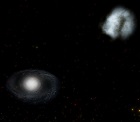|
The Search for Earthlike Atmospheres
|
|
| Watsisname | Date: Monday, 12.09.2016, 22:22 | Message # 16 |
 Galaxy Architect
Group: Global Moderators
 United States
United States
Messages: 2613
Status: Offline
| It's actually a bit too much O2 as well.
Here's a rough list of what O2, CO2, and SO2 values (in atm of partial pressure, which is second column shown in the atmosphere tab)
O2: 0.1 to 0.6
CO2: 0 to 0.04
SO2: 0 to 10-6
These have fuzzy limits in the sense that you can survive for some amount of time or with varying levels of discomfort, but for permanence I think these are about right. Feel free to add to this list or make corrections. If we compile a thorough list with good documentation I'll add it to the OP. 

|
| |
| |
| DoctorOfSpace | Date: Tuesday, 13.09.2016, 01:39 | Message # 17 |
 Galaxy Architect
Group: Global Moderators
 Pirate
Pirate
Messages: 3600
Status: Offline
| Maybe a chart should be put together that includes all of this information, similar to the ones I posted on the first page.
It would make it much easier for people to find habitable worlds if there was a quick way for people to check if it is lethal.
Intel Core i7-5820K 4.2GHz 6-Core Processor
G.Skill Ripjaws V Series 32GB (4 x 8GB) DDR4-2400 Memory
EVGA GTX 980 Ti SC 6GB
|
| |
| |
| quarior14 | Date: Tuesday, 13.09.2016, 08:57 | Message # 18 |
 World Builder
Group: Users
 Pirate
Pirate
Messages: 649
Status: Offline
| According to the book The songs of distant Earth (sci-fi), I saw that it is better to have CO2 in the atmosphere of the O2.
You will say it is unbearable but it means he does not in principle likely to meet another life form if it needs a atmosphere like us, so we can produce O2 especially convert CO2 into O2 by planting trees, maybe we will have to lean on that because I saw a lot of Terra essentially comprised of CO2 and was also inhabited, those that could cause a problem a level of ecosystem if we change the atmosphere is better found a planet without life to avoid this, but that must be fertile.
I do not know if it was the main purpose of this thread because she wants to be already Earth-like atmosphere without terraforming, but maybe it could go into account.
DoctorOfSpace, yes, it is by the way this for my second planet I saw that oxygen was too limited to breathe.
Watsisname, thank for this information additional.
Quarior
|
| |
| |
| rxwr | Date: Wednesday, 14.09.2016, 00:18 | Message # 19 |
 Observer
Group: Newbies
 Italy
Italy
Messages: 3
Status: Offline
| Yeah it would be nice to have a proper chart for dummies lol so I could go back and review all the terras I've saved
|
| |
| |
| steeljaw354 | Date: Wednesday, 14.09.2016, 10:25 | Message # 20 |
 World Builder
Group: Users
 Pirate
Pirate
Messages: 862
Status: Offline
| Why is it so hard to find Terras with breathable atmospheres?
|
| |
| |
| DoctorOfSpace | Date: Wednesday, 14.09.2016, 12:32 | Message # 21 |
 Galaxy Architect
Group: Global Moderators
 Pirate
Pirate
Messages: 3600
Status: Offline
| I think for the most part SE has it right. Earth has very specific atmospheric conditions that you really wouldn't expect to find all over the place. Though it may be exceedingly rare or not possible in SE's current generation code since no one has found a match for Earth.
Earth has some very specific conditions that lead to the atmosphere it has today. Earth has had life for a over 3 billion years, that is a long time for an atmosphere to be changed. That life evolved however due to multiple environmental variables being "just right".
Here are some conditions that Earth has that potentially could be required to find a similar world (in the real world as SE does not factor all of this)
- Not too extreme day/night cycle
- Large moon that helps stabilize it's rotation
- Decent mass, not too high and not too low of gravity
- Due to mass can hold onto a good amount of it's atmosphere
- Earth has an active dynamo which allows for shielding of the surface with it's magnetic field
- A good distance from it's parent star
- Large amounts of ocean but also a large % of land. ~70% of the oxygen in our atmosphere is produced in the ocean
- Carbon and greenhouse cycle that processes different gasses, life helps to keep this in balance
Our high oxygen content also came at a cost to life around 2.3Bil years ago when a massive die off happened because photosynthetic life continued to produce oxygen at rates the Earth could not reabsorb it. It is entirely possible that there are worlds in the universe where this happened and life never adapted. There is no guarantee either that the specific amount of gasses in our atmosphere is what all life in the universe will require. It seems more likely that life all over will produce and adapt to all kinds of variations in temperature, pressure, and available resources.
These are all interlinked with the life processes on Earth. There are probably many that I have missed, but as you can see each new piece limits the number of specific Earth like worlds in the universe.
Intel Core i7-5820K 4.2GHz 6-Core Processor
G.Skill Ripjaws V Series 32GB (4 x 8GB) DDR4-2400 Memory
EVGA GTX 980 Ti SC 6GB
|
| |
| |
| Ştefan | Date: Friday, 16.09.2016, 09:18 | Message # 22 |
|
Astronaut
Group: Users
 Romania
Romania
Messages: 44
Status: Offline
| Hello everybody! I searched a bit more for a breathable atmosphere, and I still hadn't found it. But I made some progress. I managed to find a terra with life and with a SO2 level of about 36.6*10^(-6) atm, which is still lethal, but much lower than what have I seen. Its CO2 level, however, was over the death threshold.
I have the following tips for those that search for such planets:
- look for terrae, deserts, and oceaniae
- search for atmospheres with at least 0.1 atm, or else the wouldn't be enough oxygen
- do not bother with temperature, if the world is too hot on average the poles (or the dark side) would be cold enough, and vice-versa with the equator and bright side
- search for planets with organic life, it increases the chance of it having oxygen
- when you look at the basic planetary info (without opening the atmosphere composition sheet), you'll see the major components of the atmosphere, and if you see SO2, ditch that world; it means that there is at least 1% SO2 there (and if you searched with the minimum atmospheric pressure of 0.1 atm, it means there are at least 0.001 atm of SO2, enough to kill you in 10 minutes)
I will update this post with what I have searched until now.
Centered the Earth, I have searched:
10000 Planemos, in a radius of 53 ly. None had terrae, deserts or oceaniae with life.
560 Y Class (Brown) Dwarfs, in a radius of 500 ly (over that, and my computer gets wonky). None had terrae, deserts or oceaniae with life.
10000 T Class (Brown) Dwarfs, in a radius of 341 ly. None had terrae, deserts or oceaniae with life.
10000 L Class (Brown) Dwarfs, in a radius of 190 ly. One had a terra, four had deserts and one had an oceania with life. None had breathable atmospheres.
10000 M Class (Red) Dwarf Stars, in a radius of 62 ly. 135 had terrae, 37 had deserts and 135 had oceaniae with life. None had breathable atmospheres.
10000 K Class (Orange) Dwarf Stars, in a radius of 130 ly. 355 had terrae, 46 had deserts and 262 had oceaniae with life. None had breathable atmospheres.
10000 G-Class (Yellow) Dwarf Stars, in a radius of 323 ly. I haven't analysed this stars.
Edit: A breathable atmosphere has been found, on a desert planet around a red dwarf! I will stop my search.
Edited by Ştefan - Saturday, 17.09.2016, 10:05 |
| |
| |
| 11ryanc | Date: Friday, 16.09.2016, 22:14 | Message # 23 |
 Observer
Group: Users
 United States
United States
Messages: 19
Status: Offline
| I have stumbled upon terras before that have a pretty sizable mix of O2 or N2, but they are always dominated by CO2. My gut is pushing me towards oceanias. I've been meaning to ask here if anyone has ever found Earth-like atmospherics, but I suppose this thread answers that question.
One can only imagine what wonderful Edens exist in SE that SpaceEngineer is keeping hidden from us 
Edit: This is my latest finding. Sure would be nice if all that carbon were replaced with Nitrogen.. 
Intel Core i7 4790k, MSI Z97 PC Mate, EVGA GTX 950, 16GB 1600 MHz, SanDisk SSD Plus 120GB, 2 TB WD Green, 2 TB Seagate Barracuda, Cooler Master Elite 350 Mid Tower
Windows 7 Ultimate x64 SP1
Edited by 11ryanc - Saturday, 17.09.2016, 01:16 |
| |
| |
| Ştefan | Date: Saturday, 17.09.2016, 08:22 | Message # 24 |
|
Astronaut
Group: Users
 Romania
Romania
Messages: 44
Status: Offline
| 11ryanc, the SO2 is also very high, at 0.00503 (5.03*10^(-3)) atm. This level would kill you in 3-4 minutes.
Ideally, it should be under 0.0001 (10^(-4)) to ensure survival for more than an hour or two. Lower than 0.000001 (10^(-6)) and you found a perfect atmosphere (provided you have enough O2 and under 0.04 atm CO2).
Keep searching for that elusive world! You're on the right tracks 
Edited by Ştefan - Saturday, 17.09.2016, 08:25 |
| |
| |
| DoctorOfSpace | Date: Saturday, 17.09.2016, 08:43 | Message # 25 |
 Galaxy Architect
Group: Global Moderators
 Pirate
Pirate
Messages: 3600
Status: Offline
| I asked SpaceEngineer about the current search for a second Earth and he had two things to say.
The chemical composition is very primitive and not finished.
It is impossible to know what variations can happen so there could be an Earth like world.
Intel Core i7-5820K 4.2GHz 6-Core Processor
G.Skill Ripjaws V Series 32GB (4 x 8GB) DDR4-2400 Memory
EVGA GTX 980 Ti SC 6GB
|
| |
| |
| Watsisname | Date: Saturday, 17.09.2016, 09:51 | Message # 26 |
 Galaxy Architect
Group: Global Moderators
 United States
United States
Messages: 2613
Status: Offline
| I have found one! 

A desert world, with 0.229atm surface pressure. This seems dangerously low, but at 86% O2, that's 0.197atm of oxygen, which is actually very close to Earth's. It would be like being at about 500m altitude -- you wouldn't even notice it. CO2 is at 0.0321atm, or 32,100ppm. This would be extremely uncomfortable, but it is not immediately dangerous (that's said to be at ~40,000ppm). All other gases are below 10-5atm, and the quite toxic SO2 is just below 10-6, for which there is little to no effect.
So, this atmosphere is breathable! It's probably not a place you'd like to stay for very long, though. Oh, and it's like, crazy cold here.
The story of how I found this planet is as interesting as the planet itself. I decided we were in need of more data to help us know where and how to look. Specifically, I wanted to know if different classes of stars were more conducive to finding good atmospheres, as well as what planet types. So I did separate searches for individual spectral types of main sequence stars from O to M, each with separate filters for Terra, Oceania, and Desert planets.
For all of these, I filtered by atmosphere pressure between 0.1 and 2atm, because air would have to be greater than 100% O2 to be breathable below pressures of 0.1atm. 2atm is a fairly arbitrary upper limit meant to reduce the number of results with too high partial pressure. I also filtered for Unicellular or Multicellar life (exotic life doesn't matter). The main reason being that it is much faster to find and select the resulting planets in the solar system browser if they have life on them.
The results are summarized below. For all searches O-K, I used 1000LY radius. For M, I used 100LY, so that the search is faster but still returns a lot of systems. It's important to note that the function does not return all the things that actually exist within the search volume. I split the finds up according to whether the atmospheres are dominated by CO2, by O2, or by N2 with CO2/O2 following next.
As expected, it is unlikely (if ever) to find anything around the hottest stars, O through A.
I was surprised to find anything around F stars. 6 results, 2 of which had O2 as the primary gas. One of these would be breathable except for the SO2 (as is almost always the case -- SO2 is mean). Edit: Oh, and the H2S wouldn't be very nice either -- comparable to effects of 180ppm in this table.

As we go down the spectral classes, there are more results in a given search, as we expect given the distribution of stars. 22 results for G's, one of which is O2-dominant. For K's and M's, Terras turn up more frequently (about half of results), followed by Oceanias, and then Deserts being about 10%.
It looks like the best performers are Terras around M-class stars, giving O2>CO2 24% of the time out of a sample of 99. Deserts do about as well with 19% of a sample of 27. Oceanias give 11% in a sample of 71. These may not be statistically significant differences though, and it's definitely worth looking for any of them. The most important conclusion from all of this is that we can probably find breathable air on any kind of planet (terra/oceania/desert) around any type of star (F through M).
My experience with Oceanias is that they tend to have roughly even mixtures of O2 and CO2, when what we really want is a lot less CO2. Terras tend to give the most varied atmospheres. Deserts tend to give the most simple atmospheres, sometimes with a lot of O2 and not much else. But, I don't think I've seen enough of them to be sure that this is generally true.
Of all 285 planets found in this set of searches, the one planet with breathable air happened to show up 4th from last. Lucky catch! And I had become so convinced that SO2 would so frequently be the dealbreaker for having breathable air, that when I saw this, and read the atmosphere read-out, I was in a bit of shock. I just stared at it for a long while in disbelief.
Doc:
Understood, I just still think it's interesting to see what we can find with the current generation system. The fact that it is so hard to find these kinds of atmospheres now makes them a rewarding challenge. I don't think there's any less common thing to find in SE. 

|
| |
| |
| Ştefan | Date: Saturday, 17.09.2016, 10:02 | Message # 27 |
|
Astronaut
Group: Users
 Romania
Romania
Messages: 44
Status: Offline
| Watsisname, bravo!
|
| |
| |
| DoctorOfSpace | Date: Saturday, 17.09.2016, 11:11 | Message # 28 |
 Galaxy Architect
Group: Global Moderators
 Pirate
Pirate
Messages: 3600
Status: Offline
| Nice find.
Quote Watsisname (  ) I don't think there's any less common thing to find in SE.
That is how it should be, though hopefully either through more searching or updates in the generation code someone will find a true Earth twin.
Intel Core i7-5820K 4.2GHz 6-Core Processor
G.Skill Ripjaws V Series 32GB (4 x 8GB) DDR4-2400 Memory
EVGA GTX 980 Ti SC 6GB
|
| |
| |
| 11ryanc | Date: Saturday, 17.09.2016, 22:37 | Message # 29 |
 Observer
Group: Users
 United States
United States
Messages: 19
Status: Offline
| Just stumbled upon this blue beauty: 
The atmospheric pressure is critically low though, and I'm uncertain as to how our lungs would react to the given levels of CO2 and SO2. Someone correct me if I'm wrong, but anything below 47% Earth sea pressure is fatal for terrestrial life of our type?
Would be great if somebody could cook up a chart to better help us non acquainted familiarize ourselves with our findings and draw conclusion on how habitable a given place may actually be.
Intel Core i7 4790k, MSI Z97 PC Mate, EVGA GTX 950, 16GB 1600 MHz, SanDisk SSD Plus 120GB, 2 TB WD Green, 2 TB Seagate Barracuda, Cooler Master Elite 350 Mid Tower
Windows 7 Ultimate x64 SP1
|
| |
| |
| Watsisname | Date: Sunday, 18.09.2016, 11:33 | Message # 30 |
 Galaxy Architect
Group: Global Moderators
 United States
United States
Messages: 2613
Status: Offline
| 11ryanc, beautiful blue color. That amount of oxygen and CO2 is actually breathable, but the SO2 would be immediately lethal. The H2S would be unpleasant, but not dangerous.
Quote 11ryanc (  ) Someone correct me if I'm wrong, but anything below 47% Earth sea pressure is fatal for terrestrial life of our type?
It is wrong.  It is not the reduced pressure that's fatal (at least not until we get much closer to vacuum), but the reduced availability of oxygen as air pressure gets lower. Oxygen is 21% of the air, so at 47% air pressure, this is like being at sea level but with less than 10% oxygen. And that's not enough for us. It is not the reduced pressure that's fatal (at least not until we get much closer to vacuum), but the reduced availability of oxygen as air pressure gets lower. Oxygen is 21% of the air, so at 47% air pressure, this is like being at sea level but with less than 10% oxygen. And that's not enough for us.
If you increase the concentration of oxygen in the air, then we can deal with lower pressure. See the graphic Doctor of Space posted on the first page. If the air is 100% oxygen, we can breathe at pressures even as low as 15% of sea-level (equivalent to over 40,000 ft altitude).
This is why "partial pressure" is more important than the overall air pressure. Basically we need a partial oxygen pressure between 0.1 and 0.6 atmospheres. So as long as the combination of pressure and oxygen concentration lands in that range, we can breathe it. (And provided none of the other gases have partial pressures which make them toxic.)
Quote DoctorOfSpace (  ) Maybe a chart should be put together that includes all of this information, similar to the ones I posted on the first page.
Quote 11ryanc (  ) Would be great if somebody could cook up a chart to better help us non acquainted familiarize ourselves with our findings and draw conclusion on how habitable a given place may actually be.
I agree. I've made up a text-based chart with the effects of varying levels of exposure for different gases. It's not the easiest thing to use, but it's better than trying to figure it all out from scratch. If anyone has graphic design skills and can turn it into a nice image, that would be very appreciated.  So far this contains O2, CO2, SO2, and H2S. Others should be added as well, like CO and NH3. So far this contains O2, CO2, SO2, and H2S. Others should be added as well, like CO and NH3.
Chart
How to use this:
Find the partial pressure of the gas in the atmosphere you're interested in. In Space Engine this is shown in the right-most column of the atmospheric tab when you bring up the planet's info/wiki box (by pressing "I"). Partial pressure is listed in units of atm. Basically it just means how much of the total surface pressure is caused by that particular gas. For example, if a planet has 2atm of surface pressure, and is 90% O2 and 10% CO2, then the partial pressure of O2 is 1.8atm, and CO2 is 0.2atm.
Then see where this lands in the chart to see the effects. The second column lists the partial pressure in atm. The first column lists what this would be in terms of percent by volume or ppm, if the planet had 1atm of surface pressure like Earth. (This makes for easy reference to available information on exposure effects).

|
| |
| |